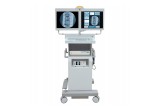
Orange County, California, May 27, 2016 (Newswire.com) - A new study highlights the necessity of health literacy within the technology advancement of diagnostic imaging. According to a recent study conducted by the Journal of the American College of Radiology, a majority of oncology patients undergo imaging screenings without understanding the nuanced risks associated with their particular procedures.
Led by Joseph R. Steele, MD, from the University of Texas MD Anderson Cancer Center in Houston, the study was sent to 48,746 randomly selected patients who had undergone diagnostic imaging at a cancer center between November 1, 2013 and January 31, 2014.
"Based on a response rate of 11.2%, or 5,462 respondents, the results revealed that the majority of patients were not adequately informed about the type of diagnostic imaging they underwent and of the inherent risks involved"
Jamie Nguyen, Sr. Communications Specialist at Ampronix
Based on a response rate of 11.2%, or 5,462 respondents, the results revealed that the majority of patients were not adequately informed about the type of diagnostic imaging they underwent and of the inherent risks involved. Whereas 35.1 percent knew that CT scans utilize ionizing radiation, 29.4 percent of respondents believed that MRI also use this type of energy.
While CT scans, X-rays, and molecular imaging utilize ionizing radiation to produce images, MRIs employ a strong magnetic field to create a scan. The notable lapse in knowledge is not surprising, considering that only 21.7 percent of respondents understood the definition of ionizing radiation.
Each diagnostic imaging procedure introduces its own set of limitations and benefits. X-rays use ionizing radiation to capture images of dense objects, like bones, to diagnose degeneration or disease. A CT scan combines ionizing radiation and a computer to capture 360-degree pictures of interior organs and the spine, among other uses. While these scans can provide a physician with internal insight, sustained exposure to ionizing radiation does present a set of potential risks.
The dose of radiation is directly tied to the type of procedure performed. Whereas absorbed radiation is measured in gray (Gy), the millisievert (mSv) is used to determine the effect of radiation based on the type used and the tissue or organs that were exposed. A coronary CT angiogram typically exerts 16 mSv, the highest on the spectrum, whereas a chest x-ray is closer to 0.02 mSv, which is the lowest. Since ionizing radiation strips electrons from atoms, there are three events that can occur; the damaged cell may either repair itself, die, or mutate. Cells have a higher propensity for repair if the dose of radiation is low and delivered over a long period of time.
Steele and colleagues also asked respondents about their attitudes and beliefs regarding the potential risks associated with radiation exposure. Findings show that 40.9 percent of respondents incorrectly believed sterility was a risk with abdomen or pelvis scans and 21.3 percent thought heritable mutations were a risk, though these beliefs are unfounded misnomers. On the other hand, 20.9 percent accurately knew that acute radiation sickness was a risk.
Nevertheless, MRIs are life-saving techniques to image organs and tissues within the body. An MRI makes use of powerful magnets, radio waves, and a computer to create detailed cross-sectional snapshots within the human anatomy. These types of screenings are especially useful to diagnose bone and joint issues. Currently, there are no potential threats from MRI scans, though any metal objects, like implants or jewelry, can cause serious harm to the patient if not removed.
Although removing the risks associated with diagnostic imaging is currently not an option, products that provide clearer images is one way in which the potential issues with small doses of radiation are mitigated. Ampronix provides OEM solutions that facilitate this very idea.
For instance, the OEC Retrofit Kit is a CRT replacement that equips radiologists with better images garnered from OEC 9800 modalities. Instead of a single low resolution CRT monitor, the kit provides physicians with dual LED displays, one of which is touch capable. To considerably improve workflow, the screens are fitted with an articulating arm that fosters 375 degree rotation.
Interestingly enough, the studied population had an average of 8.8 imaging procedures during the previous three-year period. However, an internal study of the surveyed population found that although the education level amongst them is much higher than that of the overall U.S population, they were inadequately informed of the risks.
These compounding facts are telling of a larger issue at hand; that those who are affected by diagnostic imaging are misinformed about the procedures they undergo. Thus, there is a visible need to educate patients on the actual factors that must be considered in such imaging processes.
Contact Ampronix:
Media Contact: Jamie Nguyen
Email: janguyen@ampronix.com
International Sales: +1 949-273-8000
Domestic Sales: 1800-400-7972 for US and Canada
Follow Us:
View our Product Catalog Online Here
About Ampronix
Ampronix is a renowned authorized master distributor of the medical industry's top brands as well as a world class manufacturer of innovative technology. Since 1982, Ampronix has been dedicated to meeting the growing needs of the medical community with its extensive product knowledge, outstanding service, and state-of-the-art repair facility. Ampronix prides itself on its ability to offer tailored, one-stop solutions at a faster and more cost effective rate than other manufacturers. Ampronix is ISO 13485:2003, ISO 9001:2008, and ANSI/ESD S20.20-2007 registered and certified.
Source: www.Ampronix.com
Share:






